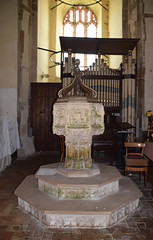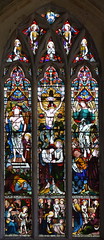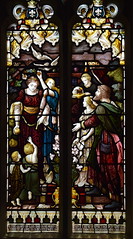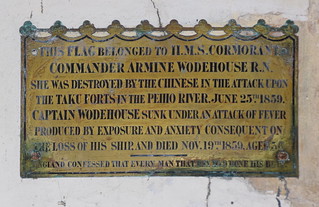| |
|
St
Andrew, Bacton It was good to
come back to Bacton. The church sits just off the
pleasant high street with its period cottages, and you
wouldn't know you are only a mile or so from the Bacton
gas terminal, one of the largest industrial complexes in
East Anglia. Because of this Bacton seems a backwater,
but in the middle ages the parish was home to Broomholm
Priory, a possessor of a substantial piece of the true
cross.
You can see Bacton church from a long way off, because
the tower is quite something. This is actually a fairly
small church, but substantial bequests in the mid-15th
century gave it a tower with a presence not quite up to
the scale of Happisburgh, but in a similar style. The
body of the nave and chancel also appears to be basically
15th century. Why so small? Perhaps the powerful presence
of the neighbouring Priory made it unnecessary to have
anything bigger. But it has to be said that St Andrew was
overwhelmingly restored in the 19th century. This is, to
all intents and purposes, a Victorian church in a
medieval shell. But it is very welcoming, open on this
day in the summer of 2019 despite the problem of falling
masonry from the chancel arch inside, which a sign
reminded us it would be prudent to stay away from.
As you might hope and expect, there are medieval
survivals, the font in particular a reminder of the sheer
opulence of late medieval East Anglia. But generally this
is a mellow, colourful place with an agreeable clutter,
where little seems to have happened since the 1890s. And
the glass has the blessing of some excellent glass in
that period in the 1860s when Robert Bayne arrived to
join Heaton & Butler and was able to exhibit his
dazzling figurative style before the firm became so
popular they had to employ other lesser artists. A
typically mundane St Peter by Kempe & Co seems to
sulk in comparison.
A battered, fading brass plate tucked behind the chancel
arch records that this flag belonged to HMS Cormorant
Commander Armine Woodhouse RN. She was destroyed by the
Chinese in the attack at the Tako forts on the Peiho
River June 25th 1859. Captain Wodehouse sunk under an
attack of fever produced by exposure and anxiety
consequent on the loss of his ship and died November 19th
1859 aged 36. Later, I found a reference to
Wodehouse in Mee's King's England: Norfolk. He
had been the rector's son. The Cormorant was a
gun boat, taking to Beijing a treaty opening up trade
between China and Europe. The flag was a sign of official
protection, but the soldiers in the Tako forts didn't
recognise it for whatever reason. Several years of war
followed.
Simon Knott, August 2019
Follow these journeys as they happen at Last Of England
Twitter.
  
   
   
 
|
|
|
